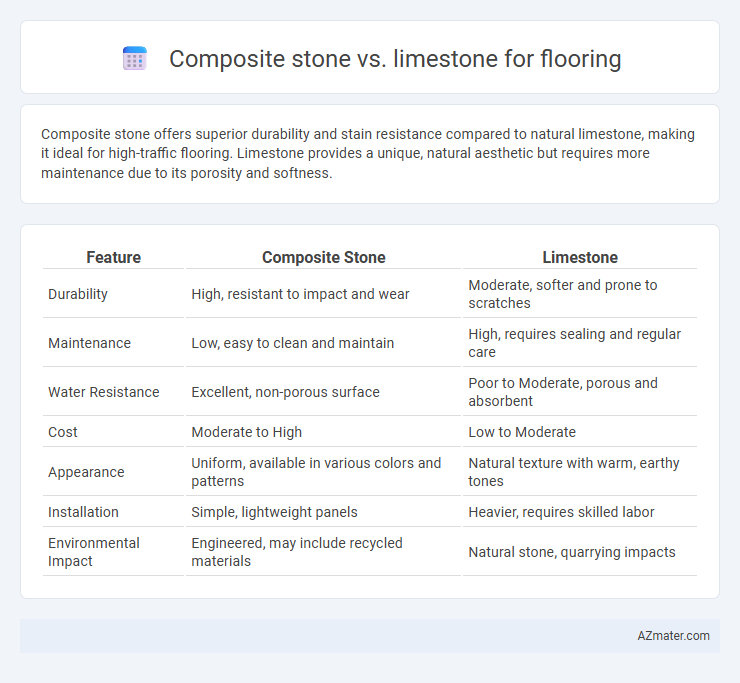Composite stone offers superior durability and stain resistance compared to natural limestone, making it ideal for high-traffic flooring. Limestone provides a unique, natural aesthetic but requires more maintenance due to its porosity and softness.
Table of Comparison
| Feature | Composite Stone | Limestone |
|---|---|---|
| Durability | High, resistant to impact and wear | Moderate, softer and prone to scratches |
| Maintenance | Low, easy to clean and maintain | High, requires sealing and regular care |
| Water Resistance | Excellent, non-porous surface | Poor to Moderate, porous and absorbent |
| Cost | Moderate to High | Low to Moderate |
| Appearance | Uniform, available in various colors and patterns | Natural texture with warm, earthy tones |
| Installation | Simple, lightweight panels | Heavier, requires skilled labor |
| Environmental Impact | Engineered, may include recycled materials | Natural stone, quarrying impacts |
Introduction to Composite Stone and Limestone Flooring
Composite stone flooring combines crushed natural stone with resins and pigments, creating a durable, versatile surface resistant to stains and scratches, ideal for high-traffic areas. Limestone flooring, a natural sedimentary rock composed primarily of calcium carbonate, offers a softer, warm aesthetic with unique textures but requires regular sealing to prevent damage from moisture and stains. Both materials provide distinct visual appeal and performance characteristics, making the choice dependent on specific design needs and maintenance preferences.
Composition and Manufacturing Differences
Composite stone flooring consists of a blend of crushed natural stone, resins, and pigments, engineered through a curing and compression process that enhances durability and allows for customizable colors and patterns. Limestone is a natural sedimentary rock primarily composed of calcium carbonate, extracted and cut into slabs or tiles with minimal processing, maintaining its organic texture and porous nature. The manufacturing of composite stone involves synthetic binding agents and controlled production techniques, whereas limestone relies on quarrying and mechanical finishing, resulting in differences in strength, maintenance, and design versatility.
Aesthetic Variations: Looks and Styles
Composite stone flooring offers a wide range of aesthetic variations, featuring vibrant colors and intricate patterns that mimic natural stone while providing consistent texture and finish. Limestone flooring presents a more subdued, elegant appearance with soft earth tones and subtle veining that enhance classic or rustic interior designs. Both materials cater to different design preferences, with composite stone excelling in customizable styles and limestone prized for its timeless, natural beauty.
Durability and Longevity Comparison
Composite stone flooring offers superior durability compared to limestone, as it is engineered to resist scratches, stains, and heavy foot traffic with minimal maintenance. Limestone, a natural sedimentary rock, is more prone to erosion, chipping, and staining, requiring regular sealing to preserve its longevity. Over time, composite stone flooring maintains its structural integrity and appearance better, making it a more resilient and long-lasting option for high-traffic areas.
Maintenance and Cleaning Requirements
Composite stone flooring offers superior durability and low maintenance, requiring only regular sweeping and occasional mopping with non-abrasive cleaners to prevent buildup. Limestone, being a softer natural stone, demands more careful cleaning using pH-neutral products and periodic sealing to protect against stains and etching. The porous nature of limestone makes it more susceptible to damage from acidic substances and moisture, increasing the frequency and care needed during maintenance compared to composite stone.
Cost Analysis: Initial and Long-Term Expenses
Composite stone flooring presents a higher initial cost compared to limestone, driven by advanced manufacturing processes and material durability. Limestone offers a more budget-friendly upfront investment but may incur greater long-term expenses due to higher maintenance and potential for damage. Evaluating total cost of ownership reveals composite stone as a cost-effective choice over time, thanks to lower repair needs and enhanced longevity.
Environmental Impact and Sustainability
Composite stone flooring offers enhanced sustainability compared to limestone by utilizing recycled materials and reducing quarrying demand, which helps preserve natural landscapes and lowers carbon emissions. Limestone extraction involves significant environmental disruption, habitat loss, and high energy consumption, contributing to greater ecological impact over time. Choosing composite stone flooring supports eco-friendly construction by promoting resource efficiency and reducing waste in flooring applications.
Installation Processes and Considerations
Composite stone flooring offers a simplified installation process due to its uniform size and lightweight nature, allowing for faster setting and reduced labor costs compared to limestone. Limestone requires careful cutting and handling because of its natural variability and softness, necessitating more skilled labor and specialized tools to prevent damage during installation. Moisture sensitivity and sealing needs are critical considerations for limestone, whereas composite stone generally provides enhanced durability and lower maintenance post-installation.
Suitability for Different Spaces and Applications
Composite stone offers superior durability and resistance to stains and scratches, making it ideal for high-traffic areas like kitchens and commercial spaces. Limestone provides a natural, elegant aesthetic perfect for low-traffic spaces such as bedrooms and living rooms but requires regular sealing to prevent damage. Both materials vary in porosity and hardness, influencing their suitability based on moisture exposure and foot traffic intensity.
Pros and Cons Summary: Which Flooring Is Best?
Composite stone flooring offers high durability, resistance to scratches and stains, and low maintenance, making it ideal for high-traffic areas. Limestone flooring provides natural beauty and a warm, textured appearance but requires regular sealing to prevent damage from moisture and stains. Choosing between composite stone and limestone depends on balancing durability and maintenance needs with aesthetic preferences for your flooring project.

Infographic: Composite stone vs Limestone for Flooring
 azmater.com
azmater.com